82 results
-
Automated facades are, for the most part, still considered as separate from other building systems throughout the design, installation,…
-
Glazed Spandrels
- Paper by Julien Schwartz, M.Eng. · Patrick Roppel, M.A.Sc, P.Eng. · Stéphane Hoffman, M.Eng, M.Arch, P.Eng, P.E. · Neil Norris, M.A.Sc, P.Eng, C.P.H.D.
Recent years have seen an increased use of insulated glazing units in spandrel applications to visually blend the appearance between the vision and
-
Design and Energy Analysis
- Paper by Mahsa Farid Mohajer, Ajla Aksamija, Professor
Integration and interoperability between Building Information Modeling (BIM) and Building Energy Modeling (BEM) tools pose major challenges for the… -

Digital Lifecycle of Building Envelopes
- Paper
“The digital transformation will change everything” – with this quote in mind a deep look into the current facade business will be given with a… -

European Facade Networks
- Paper by Ulrich Knaack, Uta Pottgiesser, Tillmann Klein, Andreas Luible, Siebe Bakker,
The European climate and energy targets for 2020 demand significant improvement of the energy performance of buildings since one third of the… -

Establishing a Life Cycle Assessment Methodology for Innovative Facade
- Paper by Vikki Lew
Life cycle assessment was introduced in the 1970s as an analytical tool to quantify the environmental impact of a product, process, or service.
-

Thermoelectric Facades
- Paper by Ajla Aksamija, PhD, LEED AP BD+C, CDT · Zlatan Aksamija, PhD · Mahsa Farid Mohajer · Meenakshi Upadhyaya · Guy Vigneau
This article discusses design, prototype development and a simulation study of novel types of facade systems, which integrate thermoelectric (TE)
-
Integrated Building Control System
- Paper by Jae Yong Suk, Ph.D., Associate Professor of Design, Associate Director of California Lighting Technology Center Keith Graeber, PE, Director of Engineering Andrew Harper, PE, R&D Engineer IV Michael Siminovitch, Ph.D., Director of California Lighting Technology Center
Integrated management of commercial lighting, heating, ventilation and air conditioning systems is considered as one of the most promising building… -

Solid Surface Material for Facades
- Paper by Christopher Payne, AIA, LEED AP, Associate
Navigating the building code, while challenging in any respect, can be even trickier when considering the use of emerging materials on building… -

Parametric Facade Design
- Paper by Patricia E. Camporeale, María del Pilar Mercader Moyano,
Parametric Design has become an invaluable tool for complex tasks like designing energy efficient buildings when joined to performance-based… -

Origami-Inspired Facade Design
- Paper by Joshua Schultz, Ph.D, P.E., LEED AP, ENV SP, Neil Katz, AIA,
To paraphrase Robert le Ricolias, the art of the structure is where to put the folds. Using that inspiration, fundamental concepts from origami,… -

Kinetic Shading Systems
- Paper by Alireza Jahanara, Negar Kalantar,
This study focuses on experiments in kinetics and architectural skins. More extensively, it introduces a solution for environmental design issues and… -

Sustainable Silicone
- Paper by Jon Kimberlain, TS&D Scientist Adrienne Bowman-Grittini, Senior Technical Service and Development Specialist Stanley Yee, TS&D Scientist
Silicone materials have a long history in high performance building projects. Known for durability, they can reduce a building’s carbon footprint by… -

Fully Tempered Glass in Spandrel Applications
- Paper by Stéphane Hoffman, PE · Lawrence D. Carbary
Recent years have seen an increase in the use of insulated glazing units (IGUs) in spandrel applications to visually blend the appearance between the
-

Rethinking Building Skins
- Paper by Eugenia Gasparri, Lecturer in Architectural Technologies Arianna Brambilla, Senior Lecturer in Architecture Gabriele Lobaccaro, Associate Professor in Solar Design and Building Performance Simulation Francesco Goia, Professor of Building Physics Annalisa Andaloro, Senior Researcher Alberto Sangiorgio, Principal Façade Engineer
Building skins play a pivotal role in architecture. Other than the aesthetical and architectural aspects, facades are key to the climate performance,… -

Detailing For Distance
- Paper by Daniel Kelso
Quickly exceeding new facade service life expectations for tall buildings imposed by increasing environmental, economic, and social pressures have
-

Envelope For Service
- Paper by Annalisa Andaloro · Miren Juaristi · Stefano Avesani · Giulia Santoro · Matteo Orlandi
Envelope-for-Service (E4S) is a novel business model developed with the aim of converting the building façade from a traditionally traded good to a
-

Low-Carbon Cladding and Shading Design
- Paper by Prateek Jain, LEED, Senior Environmental Designer Isabelle Hens, LEED GA, WELL AP, EIT,
In the last few years, the design community has embraced the challenge of reducing embodied carbon in buildings. Several tools are now available for… -

Active and Energy Autonomous Window
- Paper by Annalisa Andaloro, Leire Minguez Hilera, Stefano Avesani,
Reducing GHG emissions related to energy use in buildings is a prominent obligation given their impact in terms of climate change. In this light,… -

Adaptive Facades
- Paper by Walter Haase, Werner Sobek, Enrica Oliva, Michele Andaloro,
Facade engineering aims at appropriately balancing the demands imposed by the context and the capabilities inherent to the materials, the geometries…
